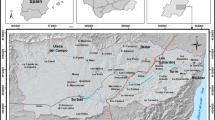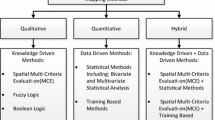Abstract
Forward logistic regression has allowed us to derive an earth-flow susceptibility model for the Tumarrano river basin, which was defined by modeling the statistical relationships between an archive of 760 events and a set of 20 predictors. For each landslide in the inventory, a landslide identification point (LIP) was automatically produced as corresponding to the highest point along the boundary of the landslide polygons, and unstable conditions were assigned to cells at a distance up to 8 m. An equal number of stable cells (out of landslides) was then randomly extracted and appended to the LIPs to prepare the dataset for logistic regression. A model building strategy was applied to enlarge the area included in training the model and to verify the sensitivity of the regressed models with respect to the locations of the selected stable cells. A suite of 16 models was prepared by randomly extracting different unoverlapping stable cell subsets that have been appended to the unstable ones. Models were finally submitted to forward logistic regression and validated. The results showed satisfying and stable error rates (0.236 on average, with a standard deviation of 0.007) and areas under the receiver operating characteristic (ROC) curve (AUCs) (0.839 for training and 0.817 for test datasets) as well as factor selections (ranks and coefficients). As regards the predictors, steepness and large-profile and local-plan topographic curvatures were systematically selected. Clayey outcropping lithology, midslope drainage, local and midslope ridges, and canyon landforms were also very frequently (from eight to 15 times) included in the models by the forward selection procedures. The model-building strategy allowed us to produce a performing earth-flow susceptibility model, whose model fitting, prediction skill, and robustness were estimated on the basis of validation procedures, demonstrating the independence of the regressed model on the specific selection of the stable cells.






Similar content being viewed by others
References
Akgün A (2012) A comparison of landslide susceptibility maps produced by logistic regression, multi-criteria decision, and likelihood ratio methods: a case study at İzmir, Turkey. Landslides 9:93–106
Akgün A, Türk N (2011) Mapping erosion susceptibility by a multivariate statistical method: a case study from the Ayvalık region, NW Turkey. ComputGeosci 37:1515–1524
Aleotti P, Chowdhury R (1999) Landslide hazard assessment: summary review and new perspectives. Bull Eng Geol Env 58:21–44
Atkinson PM, Massari R (1998) Generalised linear modeling of susceptibility to landsliding in the central Apennines, Italy. Comput Geosci 24:373–385
Ayalew L, Yamagishi H (2005) The application of GIS-based logistic regression for landslide susceptibility mapping in the Kakuda-Yahiko Mountains, Central Japan. Geomorphology 65:15–31
Baeza C, Corominas J (2001) Assessment of shallow landslide susceptibility by means of multivariate statistical techniques. Earth Surf Proc Land 26:1251–1263
Bai SB, Wang J, Lü GN, Zhou PG, Hou SS, Xu SN (2010) GIS-based logistic regression for landslide susceptibility mapping of the Zhongxian segment in the Three Gorges area, China. Geomorphology 115:23–31
Brenning A (2005) Spatial prediction models for landslide hazards: review, comparison and evaluation. Nat Hazard Sys 5:853–862
Can T, Nefeslioglu HA, GokceogluC SH, Duman TY (2005) Susceptibility assessments of shallow earthflows triggered by heavy rainfall at three catchments by logistic regression analysis. Geomorphology 72:250–271
Carrara A (1983) Multivariate models for landslide hazard evaluation. Math Geol 15:403–426
Carrara A, Cardinali M, Guzzetti F (1995) GIS technology in mapping landslide hazard. In: Carrara A, Guzzetti F (eds) Geographical information systems in assessing natural hazards. Kluwer, Dordrecht, pp 135–175
Carrara A, Crosta G, Frattini P (2008) Comparing models of debris-flow susceptibility in the alpine environment. Geomorphology 94:353–378
Chacón J, Corominas J (2003) Special issue on “landslides and GIS”. Nat Hazards 30:263–512
Chacón J, Irigaray C, Férnandez T, El Hamdouni R (2006) Engineering geology maps: landslides and geographical information systems. Bull Eng Geol Environ 65:341–411
Chauan S, Sharma M, Arora M (2010) Landslide susceptibility zonation of the Chamoli region, Garhwal Himalayas, using logistic regression model. Landslides 7:411–423
Clerici A, Perego S, Tellini C, Vescovi P (2010) Landslide failure and runout susceptibility in the upper T. Ceno valley (Northern Apennines, Italy). Nat Hazards 52:1–29
Conforti M, Robustelli G, Muto F, Critelli S (2012) Application and validation of bivariate GIS-based landslide susceptibility assessment for the Vitravo river catchment (Calabria, south Italy). Nat Hazards 61:127–141
Conoscenti C, Di Maggio C, Rotigliano E (2008) GIS analysis to assess landslide susceptibility in a fluvial basin of NW Sicily (Italy). Geomorphology 94:325–339
Costanzo D, Cappadonia C, Conoscenti C, Rotigliano E (2012a) Exporting a Google Earth™ aided earth-flow susceptibility model: a test in central Sicily. Nat Hazards 61:103–114
Costanzo D, Rotigliano E, Irigaray C, Jiménez-Perálvarez JD, Chacón J (2012b) Factors selection in landslide susceptibility modeling at large scale following the GIS-matrix method: application to the river Beiro basin (Spain). Nat Hazard Sys 12:327–340
Dai FC, Lee CF (2002) Landslide characteristics and slope instability modeling using GIS, Landau Island, Hong Kong. Geomorphology 42:213–228
Das I, Stein A, Kerle N, Dadhwal VK (2011) Probabilistic landslide hazard assessment using homogeneous susceptible units (HSU) along a national highway corridor in the northern Himalayas, India. Landslides 8:293–308
Davis JC, Ohlmacher GC (2002) Landslide hazard prediction using generalized logistic regression. Proceedings of IAMG 2002, Berlin, pp 501–506
Erener A, Düzgün HSB (2010) Improvement of statistical landslide susceptibility mapping by using spatial and global regression methods in the case of More and Romsdal (Norway). Landslides 7:55–68
Ermini L, Catani F, Casagli N (2005) Artificial neural networks applied to landslide susceptibility assessment. Geomorphology 66:327–343
Fawcett T (2006) An introduction to ROC analysis. Pattern Recogn Lett 27:861–874
Felicísimo A, Cuartero A, Remondo J, Quirós E (2012) Mapping landslide susceptibility with logistic regression, multiple adaptive regression splines, classification and regression trees, and maximum entropy methods: a comparative study. Landslides. doi:10.1007/s10346-012-0320-1
Frattini P, Crosta G, Carrara A (2010) Techniques for evaluating the performance of landslide susceptibility models. Eng Geol 111:62–72
Goodenough DJ, Rossmann K, Lusted LB (1974) Radiographic applications of receiver operating characteristic (ROC) curves. Radiology 110:89–95
Guzzetti F, Carrara A, Cardinali M, Reichenbach P (1999) Landslide hazard evaluation: a review of current techniques and their application in a multi-scale study, Central Italy. Geomorphology 31:181–216
Guzzetti F, Reichenbach P, Cardinali M, Galli M, Ardizzone F (2005) Probabilistic landslide hazard assessment at the basin scale. Geomorphology 72:272–299
Guzzetti F, Reichenbach P, Ardizzone F, Cardinali M, Galli M (2006) Estimating the quality of landslide susceptibility models. Geomorphology 81:166–184
Hanley JA, McNeil BJ (1982) The meaning and use of the area under a receiver operating characteristic (ROC) curve. Radiology 143:29–36
Hosmer DW, Lemeshow S (2000) Applied logistic regression, Wiley series in probability and statistics. Wiley, New York
Irigaray C, Fernández T, El Hamdouni R, Chacón J (2007) Evaluation and validation of landslide-susceptibility maps obtained by a GIS matrix method: examples from the Betic Cordillera (southern Spain). Nat Hazards 41:61–79
Jenness J (2006) Topographic position index (tpi_jen.avx) extension for ArcView 3.x, v. 1.3a. Jenness Enterprises. Available at: http://www.jennessent.com/arcview/tpi.htm.
Jiménez-Peralvárez J, Irigaray C, El Hamdouni R, Chacón J (2009) Building models for automatic landslide susceptibility analysis, mapping and validation in ArcGIS. NatHazards 50:571–590
Lasko TA, Bhagwat JG, Zou KH, Ohno-Machado L (2005) The use of receiver operating characteristic curves in biomedical informatics. J Biomed Inform 38:404–415
Lee S, Ryu JH, Won JS, Park HJ (2004) Determination and application of the weights for landslide susceptibility mapping using an artificial neural network. Eng Geol 71:289–302
Märker M, Pelacani S, Schröder B (2011) A functional entity approach to predict soil erosion processes in a small Plio-Pleistocene Mediterranean catchment in Northern Chianti, Italy. Geomorphology 125:530–540
Mathew J, Jha VK, Rawat GS (2009) Landslide susceptibility mapping and its validation in part of Garhwal Lesser Himalaya, India, using binary logistic regression and receiver operating characteristic curve method. Landslides 6:17–26
Mc Fadden D (1979) Quantitative methods for analyzing travel behavior of individuals: some recent developments. In: Hensher DA, Stopher PR (eds) Behavior travel modeling. Croom Helm, London, pp 279–318
Nagelkerke NJD (1991) A note on a general definition of the coefficient of determination. Biometrika 78:691–693
Nandi A, Shakoor A (2009) A GIS-based landslide susceptibility evaluation using bivariate and multivariate statistical analyses. Eng Geol 110:11–20
Nefeslioglu H, Gokceoglu C, Sonmez H (2008) An assessment on the use of logistic regression and artificial neural networks with different sampling strategies for the preparation of landslide susceptibility maps. Eng Geol 97:171–191
Ohlmacher GC, Davis JC (2003) Using multiple logistic regression and GIS technology to predict landslide hazard in northeast Kansas, USA. Eng Geol 69:331–343
Olaya V (2004) A gentle introduction to SAGA GIS. Göettingen, Germany
O'Callaghan JF, Mark DN (1984) The extraction of drainage network from digital elevation data. Comput Vision Graph 28:323–344
Pradhan B, Lee S (2010) Regional landslide susceptibility analysis using back-propagation neural network model at Cameron Highland, Malaysia. Landslides 7:13–30
Rakotomalala R (2005) Tanagra: un logiciel gratuit pour l'enseignement et la recherche. Actes De EGC:pp 697–702
Reineking B, Schröder B (2006) Constrain to perform: regularization of habitat models. Ecol Model 193:675–690
Rossi M, Guzzetti F, Reichenbach P, Mondini AC, Peruccacci S (2010) Optimal landslide susceptibility zonation based on multiple forecasts. Geomorphology 114:129–142
Rotigliano E, Agnesi V, Cappadonia C, Conoscenti C (2011) The role of the diagnostic areas in the assessment of landslide susceptibility models: a test in the Sicilian chain. Nat Hazards 58:981–999
Rotigliano E, Cappadonia C, Conoscenti C, Costanzo D, Agnesi V (2012) Slope units-based flow susceptibility model: using validation tests to select controlling factors. Nat Hazards 61:143–153
Süzen ML, Doyuran V (2004) A comparison of the GIS based landslide susceptibility assessment methods: multivariate versus bivariate. Environ Geol 45:665–679
Van Den Eckhaut M, Vanwalleghem T, Poesen J, Govers G, Verstraeten G, Vandekerkhove L (2006) Prediction of landslide susceptibility using rare events logistic regression: a case study in the Flemish Ardennes (Belgium). Geomorphology 76:392–410
Van Den Eeckhaut M, Reichenbach P, Guzzetti F, Rossi M, Poesen J (2009) Combined landslide inventory and susceptibility assessment based on different mapping units: an example from the Flemish Ardennes, Belgium. Nat Hazard Earth Sys 9:507–521
Vergari F, Della Seta M, Del Monte M, Fredi P, Lupia Palmieri E (2011) Landslide susceptibility assessment in the Upper Orcia Valley(Southern Tuscany, Italy) through conditional analysis: a contribution to the unbiased selection of causal factors. Nat Hazard Sys 11:1475–1497
Vorpahl P, Elsenbeer H, Märker M, Schröeder B (2012) How can statistical models help to determine driving factors of landslides? Ecol Model 239:27–39
Wilson JP, Gallant JC (2000) Terrain analysis: principles and applications. Wiley, Canada
Acknowledgments
The findings and discussion of this research were carried out in accordance with the bilateral agreements between the University of Palermo and the University of Granada supporting an international PhD program. All authors have commonly shared all parts of the paper. This research was supported by the project SUFRA_SICILIA funded by the Department of Earth and Sea Sciences of University of Palermo and the “Assessorato Regionale Territorio e Ambiente della Regione Sicilia”. Clare Hampton has linguistically edited the final version of this text. Authors wish to thank two anonymous referees who have allowed us to improve the quality of the paper.
Author information
Authors and Affiliations
Corresponding author
Rights and permissions
About this article
Cite this article
Costanzo, D., Chacón, J., Conoscenti, C. et al. Forward logistic regression for earth-flow landslide susceptibility assessment in the Platani river basin (southern Sicily, Italy). Landslides 11, 639–653 (2014). https://doi.org/10.1007/s10346-013-0415-3
Received:
Accepted:
Published:
Issue Date:
DOI: https://doi.org/10.1007/s10346-013-0415-3




